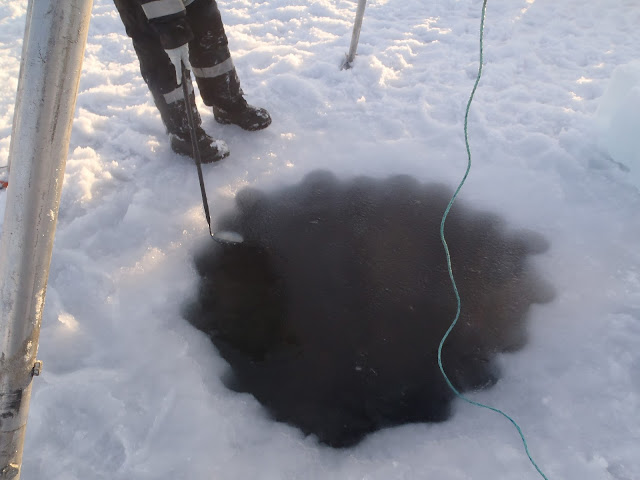To the sea ice!
14:46:00
Hey everyone!
On the 8th of March, we took a snowmobile trip to Sveagruva, a mining town
around 60 kilometres away from UNIS. The reason we went there is because it is
on Van Mijenfjorden, one of the few fjords on the west coast that still get
good, healthy annual sea ice. The point of the trip was to learn the techniques
for sampling on sea ice, as well as to actually collect samples (that we later
looked at in class).
At first, we weren’t really sure we were going to be able to
go, because there was terrible weather the day before, which resulted in a
higher risk of avalanches on the way. But in the end, the Logistics Department
at UNIS decided it was safe. And we’re lucky we went! It was an absolutely
fabulous day, and we saw the first real sun since we had gotten to Svalbard! I
had forgotten what it was like to have a shadow.
On the actual ice, before we began sampling, we had to
designate two polar bear guards – they didn’t actually participate in the
sampling. Rather, they had binoculars and a rifle, and looked out for any
bears. Because sea ice is where ringed seals spend their spring to breed, and
polar bears love a good seal dinner, there was much higher chance of an
encounter, so we had to be on the lookout.
For the actual sampling, we made holes in the ice, in order
to lower plankton nets and Niskin bottles (basically, big containers that can
take a sample of the water at a desired depth). We also took ice cores in order
to take samples of the ice community (algae, small animals, etc.) as well as to
measure the physical characteristics of the ice.
Overall, it was a very successful day! Here’s a few pictures
I took.
 |
| Only one "cheap" and efficient way to get around the snowy wilderness that is Svalbard in the winter: snowmobiles! Also a really fun way of getting around |
 |
| Our polar bear guard... A bit worrying that he seems to be looking through people... |
 |
| Here's one of the holes we made, with an electric drill and hand held saw. Someone is using a straining ladle to remove the slush that accumulates on the hole. Otherwise, it would clog the net. |
 |
| A zooplankton net (bottom right) with a really heavy cod end. We would lower and raise it using the quadrapod. |
 |
| People pulling a zooplankton net/Nisking bottle back up. Gloves were highly recommended, as the rope was wet and we were well into the minus degrees! |
 |
| This is an ice core we collected. The instrument we are probing it with is a thermometre. The ice was around 30 centimetres at that point in time (it has gotten thicker since). |
 | |
| Sun! Woo hoo! |
That was our adventure on the ice. Hopefully, we'll have more on the cruise coming up in May.
See you later!
Ivan











0 comments